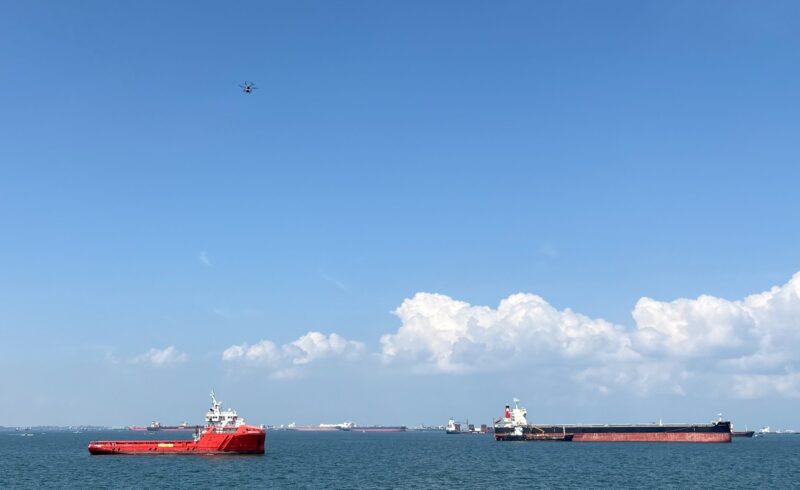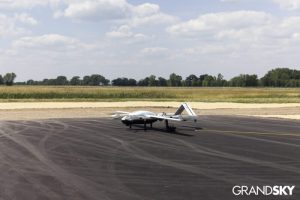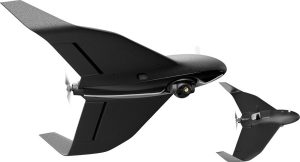Skyports and TFG Marine Complete Singapore’s First Drone Delivery to Bunker Tanker: Ushering a New Era in Maritime Logistics
Picture a scenario where fuel samples swiftly traverse above the sea, delivered by nimble drones rather than slow, swaying launch boats. This vision is becoming a reality in Singapore due to an innovative collaboration between Skyports Drone Services and TFG Marine. On July 21, 2025, they successfully accomplished Singapore’s inaugural drone delivery of bunker fuel samples from shore to ship to MT Diligence. This momentous achievement fosters both sustainability and efficiency within one of the world’s busiest ports, with significant implications for global shipping.
The Big Leap: What Was Delivered and How?
Typically in maritime operations, bunker fuel samples are delivered and collected using launch boats for quality verification and compliance, a process fraught with time consumption, costs, and potential hazards, especially in the bustling waters of Singapore, which handles over 130,000 vessel calls annually.
During this historical trial:
- A Speedbird DLV-2 drone set off from the Maritime Drone Estate, traveling beyond the visual line of sight (BVLOS) to the anchored bunker tanker.
- It was remotely controlled from the Maritime and Port Authority (MPA) of Singapore’s Maritime Innovation Lab 3.0, hovering over the ship and lowering the cargo by winch directly onto the deck.
- Managed by TFG Marine staff, the sample was secured and returned onshore for testing, completing the procedure without any human transfer at sea.
Why Does This Matter? Key Benefits Unpacked
Speed and Efficiency
- Faster turnarounds: Elimination of delays from waiting for launch boats, especially when port delays typically extend 20–30 hours at anchor in Singapore.
- On-demand delivery: Urgent items like fuel samples, documents, spare parts, or medication can now be dispatched in a matter of minutes, not hours.
Safety First
- Reduced risk to personnel: Personnel avoid the risks associated with transferring between boats, particularly in rough weather and high-traffic conditions.
- Covid-19 and biosecurity: Limiting crew transfer reduces transmission risks, a lesson underscored by the pandemic.
Sustainability
- Lower emissions: Electric drones involve no direct emissions, against the fuel-hungry nature of launch boats, aligning with goals of decarbonization.
- Less fuel burned: Reducing trips benefits the carbon footprint, especially as vessels linger at anchor longer.
Cost Savings
- Up to 80% reduction in delivery costs: Drones drastically cut expenses per delivery, with potential savings reaching up to $700 million globally by 2030 as adoption increases.
The Regulatory and Technological Context: Why Singapore?
Singapore spearheads maritime innovation, inspired by:
- The Maritime Drone Estate and MPA’s “digital-first” vision: A 5-hectare facility supports comprehensive drone R&D and commercial trials in port waters—a significant accomplishment for densely populated Singapore.
- Advanced remote operations: The trial utilized MPA’s Maritime Innovation Lab 3.0 to ensure safe, remote monitoring, minimizing on-site risks and validating advanced control frameworks.
- Stringent safety protocols: Years of testing, including electrostatic discharge, gas detection, and real-time vessel drift, were required to achieve regulatory approval, reflecting Singapore’s world-class port standards.
In April 2025, Singapore became the globe’s first port to enforce digital bunkering, compelling bunker providers to furnish digital delivery notes and services, setting a new standard in safe, tech-driven maritime transactions.
Human Stories: Real-World Impact
Kenneth Dam, Global Head of Bunkering at TFG Marine, comments:
“We continually seek avenues to enhance operational performance, focusing on transparency and reliability through digital solutions. Drone technology exhibits immense potential for reducing risks and boosting operational efficiency.”
Alex Brown, Director of Drone Services at Skyports, adds:
“In a port accommodating over 130,000 vessel calls a year, transitioning from launch boats to drones represents more than just a technical upgrade—it significantly enhances safety and sustainability.”
Visualize the relief of a vessel chief engineer receiving essential parts in under an hour, or the peace of mind for a young deckhand avoiding a dangerous launch crossing. Such human-centered advancements represent where technology truly shines.
Why Bunker Samples? And What’s Next?
Bunker fuel sampling serves as a crucial checkpoint for maintaining the shipping industry’s environmental and commercial integrity. Vessels must ensure fuel adherence to the International Maritime Organization’s (IMO) strict standards for quality and emissions. A lapse in compliance can lead to delays or penalties. Traditionally, these samples transit by boat for shore-side laboratory analysis—a headache amidst busy port times.
With drone delivery, wait times diminish without compromising chain-of-custody protocols. The successful operation involving MT Diligence lays the groundwork for broader applications:
- Routine supply delivery (spare parts, provisions)
- Emergency medications or rescue supplies
- Secure, swift document transfers
- Expanded drone inspections (for ship hulls, anchoring gear, or emissions checks)
Skyports and MPA plan to broaden pilot programs and draft standard procedures for extensive drone operations across Singapore’s maritime domain.
Expert Tips and Insights: Making the Most of Drone Delivery
Insights from this and similar deployments include:
- Choose drones with high payload reliability: Winch systems and remotely monitored precision are pivotal for safe deliveries to moving vessels.
- Data security matters: With emerging digital bunkering and e-documentation, robust encryption and audit trails are vital.
- Safety is indispensable: Comprehensive training for drone operators and vessel crews is mandatory. The finest technologies achieve little without a competent human crew.
- Watch the weather: Tropical storms in Singapore can ground drones; hence, real-time meteorological tracking and contingency strategies are essential.
The Bigger Maritime Picture: Drones Are Here to Stay
Previously the realm of science fiction—or your favorite open-world pirate game—ship-to-shore drone delivery is poised to become routine in global shipping. Singapore’s rapid digital transformation, buoyed by initiatives like the Maritime Digitalisation Blueprint 2030, sets a global benchmark.
Meanwhile, international organizations such as the IMO are keenly observing, eager to replicate success worldwide. Drones promise not only quicker deliveries but a cleaner, safer, and more transparent maritime industry.
The People Behind the Progress: Meet the Teams
Skyports Drone Services combines years of aviation and logistics acumen, merging startup agility with aviation-grade precision. Their strategists, including Michael Merritt, spearhead digital transformation in supply chains, documenting tangible savings and environmental benefits through practical data.
TFG Marine, fueling more ships than most, upholds its reputation for dependability and safety—a perfect collaborator for this landmark experiment.
The MPA, often considered “the silent captain of Singapore’s harbors,” fosters innovation with vigilant oversight and a sincere intention to forge solutions with the private sector.
What unites these teams? A shared vision of ports as gateways not just to the world but to a futuristic era.
Looking Ahead: What’s Next for Drones in Bunkering and Beyond?
With persistent port congestion and strict climate regulations, the benefits of drone logistics are set to expand. Anticipate a fast scale-up of:
- On-demand, unmanned logistics for all vessel types—from supertankers to smaller feeders.
- AI-driven route optimization and fleet management tools.
- Integration of drones with digital port platforms for seamless, end-to-end supply chain visibility.
If you are a maritime client or a logistics innovator, the message is clear: Drones are more than a trend—they are an investment in resilience, efficiency, and sustainability.
Bottom Line: Why This Matters to You
Whether you are a shipowner, marine supplier, tech enthusiast, or simply appreciate a good innovation tale, Singapore’s initial drone delivery to a bunker tanker is a landmark event to watch.
- For the industry: A paradigm for digital transformation, cost reductions, and safer operations.
- For the environment: A clear and quantifiable decrease in emissions and marine traffic dangers.
- For humanity: Time saved, lives safeguarded, and a port as futuristic as its skyline.
The next time you observe a drone overhead, imagine the revolution in global goods movement across the seas powering that quiet buzz.
Prepare to embark on the wave of drone evolution; the sky is not the limit. In the future of maritime delivery, it’s merely the beginning.













